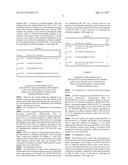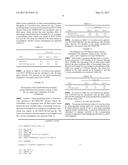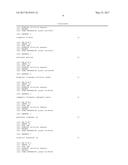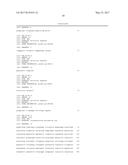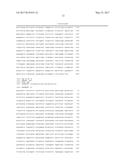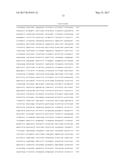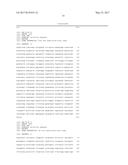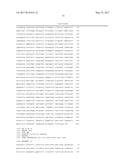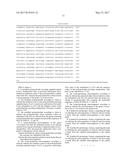Patent application title: METHOD FOR PRODUCING L-LYSINE USING MICROORGANISMS HAVING ABILITY TO PRODUCE L-LYSINE
Inventors:
IPC8 Class: AC12P1308FI
USPC Class:
1 1
Class name:
Publication date: 2017-05-25
Patent application number: 20170145453
Abstract:
The present invention relates to a modified polynucleotide encoding
aspartate kinase (EC:2.7.2.4; hereinafter, referred to as LysC),
transketolase (EC:2.2.1.1; hereinafter, referred to as Tkt) or pyruvate
carboxylase (EC:6.4.1.1; hereinafter, referred to as Pyc), in which the
initiation codon is substituted with ATG, a vector including the same, a
microorganism transformed with the vector, and a method for producing
L-lysine using the same.Claims:
1. A modified polynucleotide encoding aspartate kinase (LysC),
transketolase (Tkt), or pyruvate carboxylase (Pyc), wherein an initiation
codon of the polynucleotide is substituted with ATG, wherein the
polynucleotide is derived from a microorganism of the genus
Corynebacterium.
2. The modified polynucleotide according to claim 1, wherein the initiation codon of the polynucleotide encoding aspartate kinase (LysC) or pyruvate carboxylase (Pyc) prior to the substitution is GTG and the initiation codon of the polynucleotide encoding transketolase (Tkt) prior to substitution is TTG.
3. The modified polynucleotide according to claim 1, wherein the polynucleotides whose initiation codon are substituted with ATG are selected from the group consisting of polynucleotides that comprise the nucleotide sequences of SEQ ID NOS:16, 17 and 18.
4. A lysine-producing microorganism of the genus Corynebacterium that has enhanced activity of an enzyme selected from a group consisting of aspartate kinase (LysC), transketolase (Tkt) and pyruvate carboxylase (Pyc) compared to endogenous activity thereof, wherein the initiation codons of polynucleotides encoding the enzymes are substituted with ATG, wherein the microorganism produces more lysine than an unmodified microorganism.
5. The lysine-producing microorganism according to claim 4, wherein the initiation codon of the polynucleotide encoding aspartate kinase (LysC) or pyruvate carboxylase (Pyc) prior to the substitution is GTG and the initiation codon of the polynucleotide encoding transketolase (Tkt) prior to the substitution is TTG.
6. The lysine-producing microorganism according to claim 4, wherein the polynucleotides whose initiation codon are substituted with ATG are selected from the group consisting of polynucleotides that comprise the nucleotide sequences of SEQ ID NOS:16, 17 and 18.
7. The lysine-producing microorganism according to claim 4, wherein the microorganism of the genus Corynebacterium is Corynebacterium glutamicum.
8. A method for producing L-lysine, comprising the steps of culturing the microorganism of claim 4; and recovering L-lysine from the cultured microorganism or the culture broth.
9. A method for producing L-lysine, comprising the steps of culturing the microorganism of claim 5; and recovering L-lysine from the cultured microorganism or the culture broth.
10. A method for producing L-lysine, comprising the steps of culturing the microorganism of claim 6; and recovering L-lysine from the cultured microorganism or the culture broth.
11. A method for producing L-lysine, comprising the steps of culturing the microorganism of claim 7; and recovering L-lysine from the cultured microorganism or the culture broth.
Description:
STATEMENT REGARDING SEQUENCE LISTING
[0001] The Sequence Listing associated with this application is provided in text format in lieu of a paper copy, and is hereby incorporated by reference into the specification. The name of the text file containing the Sequence Listing is 200187_424C1_SEQUENCE_LISTING.txt. The text file is 20 KB, was created on Jan. 29, 2017, and is being submitted electronically via EFS-Web.
BACKGROUND OF THE INVENTION
[0002] 1. Field of the Invention
[0003] The present invention relates to a modified polynucleotide, in which an initiation codon is substituted with ATG, a vector comprising the same, a microorganism comprising the polynucleotide, and a method for producing L-lysine using the same.
[0004] 2. Description of the Related Art
[0005] Strains of the genus Corynebacterium, specifically Corynebacterium glutamicum, are Gram-positive microorganisms which are extensively used to produce L-lysine. L-lysine is used, for animals feed, medicines and cosmetics for humans, and is produced through fermentation of the Corynebacterium strain.
[0006] Conventionally, a strain of the genus Corynebacterium having enhanced lysine biosynthesis genes and a method of producing L-lysine using the same are known. For example, U.S. Pat. No. 6,746,855 discloses a method for producing L-lysine by culturing Corynebacterium which has an enhanced expression of lysE gene (lysine export carrier gene), and additionally introduced genes selected from the group consisting of a dapA gene, a lysC gene, a pyc gene and a dapB gene.
[0007] Another method is to amplify genes on the lysine biosynthesis pathway or to modify a promoter. For example, Korean Patent application laid-open Nos. 2009-0082702 and 2009-0084099 disclose a method for producing L-lysine by introducing improved promoters of ddh and lysC-asd operon into Corynebacterium. Korean Patent application laid-open No. 2008-0025355 discloses a method for improving lysine productivity by amplifying the copy number of the genes on the lysine biosynthesis pathway, which are aspB, lysC, asd, dapA, daps, lysA, and pyc, in the chromosome.
[0008] Meanwhile, the initiation codon which is recognized by ribosomes to initiate translation in the chromosome is usually ATG. Translation can be controlled according to the initiation codon of the gene, and the sequence of the initiation codon is important in the regulation of protein activity. However, while ATG is the common initiation codon among the lysine biosynthesis genes derived from Corynebacterium glutamicum, the initiation codon of lysC and pyc genes is GTG, and TTG is for tkt gene on pentose phosphate pathway contains the initiation codon of TTG (reference: J. Biotechnol., 104: 5-25, 2003.)
[0009] The present inventors have made many efforts to find a method for improving lysine productivity, and as a result, they found that the initiation codon of the wild-type lysC, tkt and pyc genes can be substituted with ATG to enhance the activities of aspartate kinase, transketolase and pyruvate carboxylase over their endogenous activities, thereby completing the present invention.
SUMMARY OF THE INVENTION
[0010] An object of the present invention is to provide a modified polynucleotide encoding aspartate kinase (EC:2.7.2.4; hereinafter, referred to as LysC), transketolase (EC:2.2.1.1; hereinafter, referred to as Tkt) or pyruvate carboxylase (EC:6.4.1.1; hereinafter, referred to as Pyc), wherein the initiation codon of the polynucleotide is substituted with ATG.
[0011] Another object of the present invention is to provide a vector comprising one or more modified polynucleotides encoding aspartate kinase, transketolase, or pyruvate carboxylase, in which the initiation codon of the polynucleotide is substituted with ATG
[0012] Still another object of the present invention is to provide a microorganism, in which one or more the enzymes have enhanced activity compared to their endogenous activity.
[0013] Still another object of the present invention is to provide a method for producing L-lysine, comprising the steps of culturing the microorganism, and recovering L-lysine from the cultured microorganism or the culture broth.
DETAILED DESCRIPTION OF THE PREFERRED EMBODIMENTS
[0014] In one aspect, the present invention provides a modified polynucleotide encoding aspartate kinase (EC:2.7.2.4; hereinafter, referred to as LysC), transketolase (EC:2.2.1.1; hereinafter, referred to as Tkt) or pyruvate carboxylase (EC:6.4.1.1; hereinafter, referred to as Pyc), in which the initiation codon of the polynucleotide is substituted with ATG.
[0015] Each polynucleotide encoding aspartate kinase, transketolase or pyruvate carboxylase may also include a partial substitution, deletion, insertion or addition in the polynucleotide, as long as each of them has the enzymatic activity, and may have 70% or more homology, specifically 80% or more homology, more specifically 90% or more homology, and much more specifically 95% or more homology, and most specifically 100% homology based on the known polynucleotide.
[0016] As used herein, the term "homology (homologous)" means the degree of similarity between nucleotide sequences of lysC gene, tkt gene or pyc gene of the wild-type and nucleotide sequences of the corresponding modified genes thereof, that is, modified lysC gene, tkt gene or pyc gene, in which a part of the polynucleotides is substituted, deleted, inserted or added.
[0017] As used herein, the term "initiation codon" means 3 nucleotides corresponding to a translation start point when a coding sequence of mRNA (messenger RNA) is translated into a protein. In general, initiation codons found in the chromosome of microorganisms are ATG (AUG on mRNA), GTG (GUG on mRNA) and TTG (UUG on mRNA), and they exist in a ratio of 62.5%.about.66.5%, 23.1%.about.24.3% and 10.3%.about.13.2% according to the analysis result of the entire genome sequence of Corynebacterium glutamicum (reference: Handbook of Corynebacterium glutamicum, 40 p, Lothar Eggeling & Michael Bott, 2005).
[0018] Among the lysine biosynthesis genes derived from Corynebacterium reported until now, lysC and pyc have the initiation codon of GTG, and tkt has the initiation codon of TTG. The initiation codon of these genes is not ATG, which is regarded as a unique characteristic of Corynebacterium.
[0019] The modified polynucleotide according to the present invention is characterized in that the initiation codon of the lysC, tkt or pyc gene is substituted with ATG, and these modified polynucleotides having such substituted initiation codon have been first modified by the present inventors. In more detail, GTG initiation codon of the polynucleotide encoding aspartate kinase (LysC) or pyruvate carboxylase (Pyc) is substituted with ATG, and TTG initiation codon of the polynucleotide encoding transketolase (Tkt) is substituted with ATG in the present invention. More specifically, the sequences of lysC, tkt, and pyc genes are SEQ ID NOs. 13, 14, and 15, respectively, the sequences of the genes having the substituted initiation codon as ATG are represented by SEQ ID NOs. 16, 17, and 18, respectively.
[0020] The base substitutions of the initiation codons may be performed by any method known in the art, for example, site-specific mutagenesis, homologous recombination, but is not limited thereto.
[0021] In another aspect, the present invention provides a vector comprising one or more modified polynucleotides of the modified polynucleotides encoding aspartate kinase, transketolase or pyruvate carboxylase, in which the initiation codon of the polynucleotide is substituted with ATG.
[0022] The modified polynucleotides having the substituted initiation codon as ATG and encoding aspartate kinase, transketolase or pyruvate carboxylase, which is comprised in the vector of the present invention, may include those in which a part of the polynucleotides is substituted, deleted, inserted or added, as long as they have enzymatic activity, and may have 70% or more homology, specifically 80% or more homology, more specifically 90% or more homology, much more specifically 95% or more homology, and most specifically 100% homology.
[0023] Further, the modified polynucleotides having the substituted initiation codon as ATG and encoding aspartate kinase, transketolase or pyruvate carboxylase, which is comprised in the vector of the present invention, may also include only a part of the gene encoding aspartate kinase, transketolase or pyruvate carboxylase, as long as they have the substituted initiation codon as ATG.
[0024] As used herein, the term "vector" refers to a DNA construct that contains a base sequence which is operably linked to a suitable control sequence, to expresses a target gene in a suitable host. The control sequences may include a promoter to initiate transcription, a certain operator sequence to control such transcription, a sequence encoding a suitable ribosome-binding site on the mRNA, and a sequence to control termination of transcription and translation. The vector used in the present invention is not particularly limited, and may be any vector known in the art, as long as it is replicable in the host. For example, the vector may be a plasmid, a phage particle, or a potential genome insert, and is specifically pDZ (Korean Patent No. 10-0924065), but is not limited thereto. Once transformed into a suitable host, the vector may be replicated or function independently of the host genome, or may be integrated into the genome itself.
[0025] Specifically, a nucleotide sequence (SEQ ID NO. 13, 14 or 15) comprising the initiation codon of the lysC, tkt or pyc gene was acquired, and based on this sequence, primers having the substituted initiation codon as ATG were synthesized. PCR was carried out using the primers and a chromosomal DNA of an L-lysine-producing strain as a template, so as to obtain DNA of which one end is substituted with ATG. This DNA fragment thus obtained was cloned into a vector to obtain a final recombinant vector. More specifically, in the present invention, pDZ-lysC(ATG), pDZ-tkt (ATG) and pDZ-pyc(ATG) vectors were constructed, respectively.
[0026] In still another aspect, the present invention provides a microorganism which includes one or more modified polynucleotides having the substituted initiation codon as ATG and encoding an enzymes selected from the group consisting of aspartate kinase, transketolase and pyruvate carboxylase, and then improved in translation levels of mRNAs transcribed from the polynucleotides into proteins, resulting in enhanced activities of one or more of the enzymes compared to endogenous activities thereof. The microorganism of the present invention may have enhanced activities of aspartate kinase, transketolase or pyruvate carboxylase by using the modified polynucleotides in combinations of one, two, or three thereof, in which the modified polynucleotides encode the corresponding enzymes and are substituted with ATG on initiation codon.
[0027] In order to substitute ATG for the initiation codons of the target genes on the chromosome of the microorganism, various methods known in the art can be used. For example, the initiation codon sequences of endogenous lysC, tkt and pyc genes in the microorganism can be substituted on the chromosome. Alternatively, the corresponding genes having substituted initiation codon sequences can be introduced into the microorganism in the form of a plasmid.
[0028] The microorganism may be any strain, as long as it has L-Iysine productivity. Specifically it may be a microorganisms of Corynebacterium sp. or Brevibacterium sp. Examples of the microorganisms of Corynebacterium sp. or Brevibacterium sp. include Corynebacterium glutamicum ATCC13032, Corynebacterium thermoaminogenes FERM BP-1539, Brevibacterium flavum ATCC 14067, Brevibacterium lactofermentum ATCC 13869. Further, L-lysine-producing variants or stains derived therefrom, for example, Corynebacterium glutamicum KCCM11016P (this microorganism was disclosed as KFCC10881, and re-deposited to an International Depositary Authority under the Budapest Treaty with Accession No. KCCM11016P, Korean Patent No. 10-0159812, Korean Patent No. 10-0397322) and Corynebacterium glutamicum KFCC 11001, may be included. Further more may be Corynebacterium glutamicum with Accession No. KCCM11016P.
[0029] Specifically, Corynebacterium glutamicum with Accession No. KCCM11016P was transformed with a vector comprising the polynucleotide encoding aspartate kinase, transketolase or pyruvate carboxylase wherein the initiation codon is substituted with ATG, to obtain recombinant Corynebacterium glutamicum. More Specifically, pDZ-lysC(ATG) , pDZ-tkt(ATG) or pDZ-pyc(ATG) vector was introduced into Corynebacterium glutamicum with Accession No. KCCM11016P, respectively so as to obtain each recombinant Corynebacterium glutamicum.
[0030] Further, the microorganism can be transformed with a vector comprising two or more polynucleotides of the polynucleotides encoding aspartate kinase, transketolase or pyruvate carboxylase and having the substituted initiation codon as ATG. Specifically, the pDZ-tkt(ATG) vector comprising the gene of which the initiation codon has been substituted with ATG and encodes transketolase is transformed into Corynebacterium glutamicum KCCM11016P-lysC, in which GTG initiation codon of lysC is substituted with ATG, and through second crossover, the initiation codons of lysC and tkt on the chromosome are substituted with ATG so as to obtain Corynebacterium glutamicum KCCM11016P-lysC-tkt. Further, the pDZ-pyc(ATG) vector comprising the polynucleotide of which the initiation codon has been substituted with ATG and encodes pyruvate carboxylase is transformed into KCCM11016P-lysC, in which GTG initiation codon of lysC is substituted with ATG, and through second crossover, the initiation codons of lysC and pyc on the chromosome are substituted with ATG so as to obtain KCCM11016P-lysC-pyc. Furthermore, the pDZ-tkt(ATG) vector is transformed into KCCM11016P-lysC-pyc as prepared above, in which GTG initiation codon of lysC and pyc is substituted with ATG, and through second crossover, the initiation codons of lysC, pyc and tkt on the chromosome are substituted with ATG so as to obtain KCCM11016P-lysC-pyc-tkt. It was confirmed that the initiation codons of lysC, pyc and tkt can be also substituted with ATG in another lysine-producing strains belonging to Corynebacterium glutamicum, KFCC10750 (this microorganism was disclosed as KFCC10750, and re-deposited to an International Depositary Authority under the Budapest Treaty with Accession No. KCCM11347P, Korean Patent No. 10-0073610), KCCM10770P (Korean Patent No. 10-0924065), CJ3P (Genome Biology 2012, 13:R40) in the same manner. These results suggest that the modified introduced into various strains belonging to Corynebacterium sp., thereby increasing L-lysine productivity.
[0031] Specifically, the transformant KCCM11016P-lysC-pyc-tkt, which was obtained by introducing pDZ-lysC(ATG), pDZ-tkt(ATG) and pDZ-pyc(ATG) vectors including the polynucleotides encoding aspartate kinase, transketolase and pyruvate carboxylase into Corynebacterium glutamicum KCCM11016P, was designated as Corynebacterium glutamicum CA01-2059, and deposited on May 2, 2011 at the Korean Culture Center of Microorganisms (hereinafter, abbreviated to "KCCM"), which is an International Depositary Authority under the Budapest Treaty, under Accession No. KCCM11188P. It is deposited by an International Depositary Authority under the Budapest Treaty.
[0032] The microorganism according to the present invention is characterized in that the initiation codons of the wild-type genes encoding the above enzymes are substituted with ATG, and therefore, the microorganism has enhanced activities of aspartate kinase, transketolase and pyruvate carboxylase compared to endogenous activities thereof, resulting from remarkable improvement in translation levels of mRNAs transcribed from the lysC, tkt and pyc genes into the proteins.
[0033] As used herein, the term "endogenous activity" means the activity of an enzyme in a native microorganism, and for example, the activity of aspartate kinase, transketolase or pyruvate carboxylase in a native microorganism belonging to Corynebacterium sp. The term "enhanced endogenous activity" means that the activity is further improved compared to that of the native enzyme.
[0034] Specifically, when the aspartate kinase activity of the strain in which the initiation codon of lysC gene was substituted with ATG was compared to that of the parent strain KCCM11016P, 2.73-fold increase in the aspartate kinase activity was observed (Table 4). Further, when the transketolase activity of the strain in which the initiation codon of tkt gene was substituted with ATG was compared to that of the parent strain KCCM11016P, 3.5-fold increase in the transketolase activity was observed (Table 5). Furthermore, when the pyruvate carboxylase activity of the strain in which the initiation codon of pyc gene is substituted with ATG was compared to that of the parent strain KCCM11016P, 1.89-fold increase in the pyruvate carboxylase activity was observed (Table 6).
[0035] It was found that L-lysine productivity of the microorganism can be increased by improving the activity of aspartate kinase, transketolase, pyruvate carboxylase or a combination thereof.
[0036] In the present invention, the amounts of L-lysine produced in the L-lysine-producing strains, Corynebacterium glutamicum KCCM11016P-lysC, KCCM11016P-tkt, KCCM11016P-pyc, KCCM11016P-lysC-tkt, KCCM11016P-lysC-pyc, and KCCM11016P-lysC-pyc-tkt were measured, and as a result, they showed a remarkable improvement in the L-lysine production compared to the parent strain KCCM11016P (Table 7). Also, another lysine-producing strains belonging to Corynebacterium glutamicum, KFCC10750 (Korean Patent No. 10-0073610), KCCM10770P (Korean Patent No. 10-0924065), and CJ3P (Genome Biology 2012, 13:R40), in which initiation codons of lysC, pyc and tkt were substituted with ATG, showed a remarkable improvement in the L-lysine production compared to the parent strain (Tables 8-10). These results suggest that microorganisms having one type of modified polynucleotides encoding LysC, Tkt, or Pyc, or having two types of the modified polynucleotides encoding the enzymes, or having three types of modified polynucleotides encoding the enzymes and having the substituted initiation codon as ATG on the chromosome, also showed remarkably improved L-lysine productivity compared to the wild-type microorganism having GTG or TTG initiation codon.
[0037] In still another aspect, the present invention provides a method for producing L-lysine, comprising the steps of culturing the microorganism as described above; and recovering L-lysine from the cultured microorganism or the culture broth.
[0038] For the cultivation, various methods of producing L-lysine using a microorganism which are widely known in the art can be used. The cultivation can be carried out according to the widely known method, and conditions for the cultivation, including temperature, time, pH of medium, etc. may be controlled properly. A detailed description of the cultivation is given in the following document [Chmiel; Bioprozesstechnik 1. Einfuhrung in die Bioverfahrenstechnik (Gustav Fischer Verlag, Stuttgart, 1991), and Storhas; Bioreaktoren und periphere Einrichtungen (Vieweg Verlag, Braunschweig/Wiesbaden, 1994)]. Further, the cultivation may include batch culture, continuous culture, and fed-batch culture. Specifically, a batch, fed batch or repeated fed batch process may be operated in a continuous manner, but the present, invention is not limited thereto.
[0039] For use in the cultivation, a medium must satisfy the requirement of a particular strain employed. Culture media for microorganisms belonging to Corynebacterium sp. are well known (e.g., Manual of Methods for General Bacteriology. American Society for Bacteriology. Washington D.C., USA, 1981). Carbon sources to be used may include saccharides and carbohydrates such as glucose, sucrose, lactose, fructose, maltose, starch and cellulose; oils and lipids such as soybean oil, sunflower seed oil, castor oil and coconut oil; fatty acids such as palmitic acid, stearic acid, linoleic acid; alcohols such as glycerol and ethanol; and organic acids such as acetic acid. These materials may be used separately or in combination. Nitrogen sources to be used may include peptone, yeast extract, meat broth, malt extract, corn steep liquor, soybean meal and urea, or inorganic compounds such as ammonium sulfate, ammonium chloride, ammonium phosphate, ammonium carbonate and ammonium nitrate. These nitrogen sources may be used separately or in combination. Phosphorus sources to be used may include dipotassium hydrogen phosphate, potassium dihydrogen phosphate, and corresponding sodium salts. In addition, culture media may contain metal salts such as magnesium sulfate or iron sulfate essential for the growth. Lastly, essential nutrients such as amino acids and vitamins may be used in addition to the above substances. In addition, proper precursors may be added into the culture media. These materials may be properly added into the culture during cultivations in a batch or continuous mode.
[0040] The pH of the culture media may be adjusted with a basic compound such as sodium hydroxide, potassium hydroxide or ammonia, or an acidic compound such as phosphoric acid or sulfuric acid. The generation of foam may be restrained using an anti-foaming agent such as fatty acid polyglycol ester. The culture media may be kept under aerobic conditions by introducing oxygen or an oxygen-containing gas (e.g., air) thereto. The culture temperature is typically between 20 and 45.degree. C. and specifically between 25 and 40.degree. C. The culturing is continued until a maximal amount of L-lysine is produced. In this regard, it may be accomplished within 10 to 160 hrs. After being produced, L-lysine may be exported into the culture media or may remain within the cells.
[0041] Further, the method for producing L-lysine of the present invention comprises the step of recovering L-lysine from the cultured microorganism or the culture broth. The method of recovering L-lysine from the microorganism or the culture broth is widely known in the art. Examples of the L-lysine recovering method may include filtration, anion exchange chromatography, crystallization and HPLC, but are not limited thereto.
EXAMPLES
[0042] Hereinafter, the present invention will be described in more detail with reference to Examples. However, these Examples are for illustrative purposes only, and the invention is not intended to be limited by these Examples.
[0043] In the Examples, recombinant vectors for substituting ATG for GTG or TTG initiation codon of lysC gene encoding aspartate kinase, tkt gene encoding transketolase, and pyc gene encoding pyruvate carboxylase derived from the lysine-producing strain, Corynebacterium glutamicum KCCM11016P, were constructed. The vector was transformed into Corynebacterium glutamicum KCCM11016P strain to obtain a strain having the substituted initiation codon on the chromosome, thereby preparing a strain having improved lysine productivity.
[0044] Corynebacterium glutamicum KCCM11016P strain used in the present invention is a strain which is resistant to S-(2-aminoethyl) cysteine (hereinafter, referred to as AEC) and is homoserine-leaky, prepared by artificial mutation using wild-type Corynebacterium glutamicum (ATCC 13032) as a parent strain (disclosed as KFCC10881. See Korean Patent No. 10-0159812 and Korean Patent No. 10-0397322). Further, KFCC10750 strain is a Corynebacterium glutamicum L-lysine-producing strain which is homoserine auxotroph and resistant to an L-leucine analog, 4-azaleucine and an antibiotic rifampicin, prepared by artificial mutation (Korean Patent No. 10-0073610), KCCM10770P strain is an L-lysine-producing strain derived from KCCM11016P, which retains two copies of 6 types of the genes constituting the lysine biosynthesis pathway on the chromosome (Korean Patent No. 10-0924065), and CJ3P strain is a Corynebacterium glutamicum strain which has L-lysine productivity by introducing each of P458S, V59A, and T311I mutations into three types of pyc, hom, and lysC genes of the wild type, based on the description by Binder et al. (Genome Biology 2012, 13:R40).
Example 1
Construction of Recombinant Vector (pDZ-lysC(ATG)) having Substituted ATG Initiation codon in lysC Derived from Corynebacterium glutamicum and Preparation of Strain having Substituted Initiation codon
[0045] pDZ (see Korean Patent No. 10-0924065) was used as a basic vector for the recombinant vector, which was constructed as follows.
[0046] (1) Construction of pDZ-lysC (ATG) Recombinant Vector
[0047] In order to acquire lysC gene derived from Corynebacterium glutamicum, chromosomal DNA of a lysine-producing strain (Corynebacterium glutamicum KCCM11016P) prepared by artificial mutation was used as a template. Based on the genbank at the U.S. National Institutes of Health (NIH GenBank), a nucleotide sequence (SEQ ID NO. 13) containing the initiation codon region of lysC gene (NCBI Accession No. NC_003450, Ncg10247) was acquired, and based on this sequence, two pairs of primers (Table 1, SEQ ID NOs. 1.about.4) for substituting the initiation codon GTG with ATG were synthesized.
[0048] PCR was carried out using chromosomal DNA of KCCM11016P as a template and primers of the following Table 1. PfuUltra.TM. High-Fidelity DNA polymerase (Stratagene) was used as a polymerase, and PCR was performed with 30 cycles of denaturation at 96.degree. C. for 30 seconds; annealing at 55.degree. C. for 30 seconds; and polymerization at 72.degree. C. for 30 seconds. Two DNA fragments thus obtained were cloned into pDZ vector treated with restriction enzyme XbaI using an In-Fusion PCR cloning kit (Clontech), and finally, a pDZ-lysC(ATG) recombinant vector was constructed.
[0049] (2) Preparation of Strain
[0050] The pDZ-lysC(ATG) vector thus constructed was transformed into KCCM11016P by an electric pulse method (by use of the transformation method according to Appl. Microbiol. Biotechnol. (1999) 52:541-545), and then strains, in which the gene was inserted into the chromosome by homologous recombination, were selected on a selection medium containing 25 mg/L of kanamycin. The successful chromosomal insertion of the vector was confirmed by the blue color of the colonies on a solid medium containing X-gal (5-bromo-4-chloro-3-indolyl-(.beta.-D-galactoside). The strain with the first chromosomal insertion was shaking-cultured (30.degree. C., 8 hours) in a nutrient medium. Then, the cultured strain was serially diluted from 10.sup.-4 to 10.sup.-10, and the diluted culture was plated on a solid medium containing X-gal. Most colonies exhibited blue color, whereas white colonies also existed at a low level. By selecting the white colonies, strains in which the nucleotide sequence at the initiation codon region of lysC was substituted via a second crossover were selected. The nucleotide substitution of the initiation codon in the selected strain was finally confirmed by PCR using the primers of SEQ ID NOs. 1 and 4 and then by analyzing the nucleotide sequence of the target site.
TABLE-US-00001 TABLE 1 SEQ ID Primer Nucleotide sequence NO. lysC/ATG/ CCGGGGATCCTCTAGActtagggagccatcttttgg 1 FX lysC/ATG/ CCAGGGCCATCTTTGTGC 2 R lysC/ATG/ GCACAAAGATGGCCCTGG 3 F lysC/ATG/ GCAGGTCGACTCTAGAAGTGACATCAACAATGCGTG 4 RX
Example 2
Construction of Recombinant Vector (pDZ-tkt(ATG) ) having Substituted ATG Initiation Codon in tkt Derived grom Corynebacterium glutamicum and Preparation of Strain having Substituted Initiation codon
[0051] There are two codons which are expected as an initiation codon on the sequence of tkt gene. Based on the distance from RBS (Ribosomal binding site) and proteomics, the downstream codon was determined as the initiation codon in the present invention.
[0052] (1) Construction of pDZ-tkt(ATG) Recombinant Vector
[0053] In order to acquire tkt gene derived from Corynebacterium glutamicum, chromosomal DNA of KCCM11016P was used as a template. Based on the genbank at the U.S. National Institutes of Health (NIH GenBank), a nucleotide sequence (SEQ ID NO. 14) containing the initiation codon region of tkt gene (NCBI Accession No. NC_003450, Ncg11512) was acquired, and based on this sequence, two pairs of primers (Table 2, SEQ ID NOs. 5.about.8) for substituting the initiation codon TTG with ATG were synthesized.
[0054] PCR was carried out using chromosomal DNA of KCCM11016P as a template and primers of the following Table 2 under the conditions of Example 1-1. Two DNA fragments thus obtained were cloned into pDZ vector treated with restriction enzyme XbaI using an In-Fusion PCR cloning kit (Clontech), and finally, a pDZ-tkt(ATG) recombinant vector was constructed.
[0055] (2) Preparation of Strain
[0056] The pDZ-tkt(ATG) vector thus constructed was transformed into the lysine-producing strain KCCM11016P in the same manner as in Example 1-2, and KCCM11016P-tkt, in which the initiation codon of tkt on the chromosome was substituted with ATG via a second crossover, was obtained. The nucleotide substitution of the initiation codon of the gene was finally confirmed by PCR using the primers of SEQ ID NOs. 5 and 8 and then by analyzing the nucleotide sequence of the target site.
TABLE-US-00002 TABLE 2 SEQ ID Primer Nucleotide sequence NO. tkt/ATG/ CCG GGG ATC CTC TAG A GAA ATA GAT 5 FX GGG TGT AGA CG tkt/ATG/ GTGACAGCGTCATGGTGGTCAAT 6 R4 tkt/ATG/ ATTGACCACCATGACGCTGTCAC 7 F4 tkt/ATG/ GCA GGT CGA CTC TAG A CGC AGA GCC 8 RX TTC AGG TCA TC
Example 2
Construction of Recombinant Vector (pDZ-pyc(ATG)) having Substituted ATG Initiation codon in pyc Derived From Corynebacterium Glutamicum and Preparation of Strain having Substituted Initiation codon
[0057] (1) Construction of pDZ-pyc(ATG) Recombinant Vector
[0058] In order to acquire pyc gene derived from Corynebacterium glutamicum, chromosomal DNA of KCCM11016P was used as a template. Based, on the genbank at the U.S. National Institutes of Health (NTH GenBank), a nucleotide sequence (SEQ ID NO. 15) containing the initiation codon region of pyc gene (NCBI Accession No. NC_003450, Ncg10659) was acquired, and based on this sequence, two pairs of primers (Table 3, SEQ ID NOs. 9.about.12) for substituting the initiation codon GTG with ATG were synthesized.
[0059] PCR was carried, out using chromosomal DNA of KCCM11016P as a template and primers of the following Table 3 under the conditions of Example 1-1. Two DNA fragments thus obtained were cloned into pDZ vector treated with restriction enzyme XbaI using an In-Fusion PCR cloning kit (Clontech), and finally, a pDZ-pyc(ATG)recombinant vector was constructed.
[0060] (2) Preparation of Strain
[0061] The pDZ-pyc(ATG) vector thus constructed was transformed into the lysine-producing strain KCCM11016P in the same manner as in Example 1-2, and KCCM11016P-pyc, in. which the initiation codon of pyc on the chromosome was substituted with ATG via a second crossover, was obtained. The nucleotide substitution of the initiation codon of the gene was finally confirmed by PCR using the primers of SEQ ID NOs. 9 and 12 and then by analyzing the nucleotide sequence of the target site.
TABLE-US-00003 TABLE 3 SEQ ID Primer Nucleotide sequence NO. pyc/ATG/ CCGGGGATCCTCTAGATTTTGGGGAAAA 9 FX GTGCAAAG pyc/ATG/ GAGTCGACAtTAGAGTAAT 10 R pyc/ATG/ ATTACTCTAaTGTCGACTC 11 F pyc/ATG/ GCAGGTCGACTCTAGAGGGCATTTTCAGACAGGAAG 12 RX
Example 4
Measurement of Enzymatic Activity of aspartate kinase in Strain having Substituted ATG Initiation codon in lysC gene
[0062] The cells in the exponential phase were collected by centrifugation (5,000 rpm, 15 minutes) and washed three times with 0.1% Tris.KCl (pH 8.0) buffer, and then suspended in the same buffer for a turbidity at 610 nm of 160. The cells were disrupted for 6 minutes using a bead beater after glass beads added at 1.25 g/1.5 ml of the suspension. The supernatant was collected by centrifugation (15,000 rpm, 20 minutes), and quantitatively measured for protein content by a Bradford method (Bradford, M. M 1976. Anal. Biochem. 72:248-254) and used as a crude protein solution for measuring the enzymatic activity of aspartate kinase (LysC). In order to quantify the enzymatic activity of LysC, about 0.05 mL of the crude protein solution was added to a reaction solution containing 0.1 M Tris.HCl (pH 8.0), 0.01 M magnesium chloride (MgCl.sub.2), 0.6 M hydroxylamine.HCl (pH 7.0), 4 mM ATP, and 0.2 M aspartate to initiate the reaction. The mixture was allowed to react at 30.degree. C. for 30 minutes, and a stop solution (10% FeCl.sub.2, 3.3% TCA, 0.7 N HCl) was added to terminate the reaction. The supernatant was collected by centrifugation, and absorbance at 540 nm was measured. The unit (U) of the LysC enzymatic activity was defined as nmole of the aspartate hydroxamate produced by 1 mg of protein for 1 minute.
[0063] KCCM11016P-lysC strain was observed to have 2.73-fold higher LysC activity than that of the parent strain KCCM11016P (Table 4).
TABLE-US-00004 TABLE 4 LysC enzymatic activity Enzymatic activity (Fold) Strain LysC KCCM11016P 1.00 KCCM11016P-lysC 2.73
Example 5
Measurement of Enzymatic Activity of transketolase in Strain having Substituted ATG Initiation codon in tkt gene
[0064] The cells in the exponential phase were collected by centrifugation (5,000 rpm, 15 minutes) and washed three times with 0.1% Tris.KCl (pH 7.5) buffer, and then suspended in the same buffer for a turbidity at 610 nm of 160. The cells were disrupted for 6 minutes using a bead beater after glass beads added at 1.25 g/1.5 ml of the suspension. The supernatant was collected by centrifugation (15,000 rpm, 20 minutes), and quantitatively measured for protein content by a Bradford method and used as a crude protein solution for measuring the enzymatic activity of transketolase (Tkt). In order to quantify the enzymatic activity of Tkt, the crude protein solution was added to a reaction solution containing 0.1 M Tris.HCl (pH 7.5), 10 mM D-R5P, 2 mM D-Xu5P, 10 .mu.M ThDP, 1.2 mM MgCl.sub.2, 100 .mu.M NADH, 1 unit triosephosphate isomerase, 1 unit glycerol-3-phosphate dehydrogenase per 1 ml to initiate the reaction. The mixture was allowed to react at 30.degree. C. for 20.about.30 minutes, and absorbance at 340 nm was measured. The unit (U) of the Tkt enzymatic activity was defined as the amount (mg) of the enzyme catalyzing production of 1 .mu.mol of glyceraldehyde 3-phosphate for 1 minute, and specific activity was defined as units/mg (Biochem. J. (2004) 382, 759-767).
[0065] KCCM11016P-tkt strain was observed to have 3.5-fold higher Tkt activity than that of the parent strain KCCM11016P (Table 5).
TABLE-US-00005 TABLE 5 Tkt enzymatic activity Enzymatic activity (Fold) Strain Tkt KCCM11016P 1.00 KCCM11016P-tkt 3.5
Example 6
Measurement of Enzymatic Activity of pyruvate carboxylase in Strain having Substituted ATG Initiation codon in pyc gene
[0066] The cells in the exponential phase were collected by centrifugation (5,000 rpm, 15 minutes) and washed twice with 50 mM Tris.HCl (pH 6.3) buffer containing 50 mM sodium chloride (NaCl), and then suspended in 100 mM HEPES (pH 7.5) buffer containing 20% glycerol, CTAB was added to the suspension to a concentration of 0.3%, and left on ice for 1 minute. The cells were collected by centrifugation (5,000 rpm, 10 minutes) and then suspended in 100 mM Tris.HCl (pH 7.3) buffer. The protein content was quantitatively measured by a Bradford method and used as a crude protein solution for measuring the enzymatic activity of pyruvate carboxylase (Pyc). In order to quantify the enzymatic activity of Pyc, the crude protein solution was added to a reaction solution containing 25 mM NaHCO.sub.3, 5 mM MgCl.sub.2, 3 mM pyruvate, and 4 mM ATP to initiate the reaction. The mixture was allowed to react at 30.degree. C. for 1.5 minutes, and 80 .mu.l of a stop solution (30% o-phosphoric acid) was added to terminate the reaction. The supernatant was collected by centrifugation (12,000 rpm, 15 min, 4.degree. C.) . 50 .mu.l of the supernatant, 150 mM Tris.HCl (pH 7.8), 150 .mu.M NADH, and 2.5 U lactate dehydrogenase were added per 1 ml and absorbance at 340 nm was measured at 37.degree. C. The unit (U) of the Pyc enzymatic activity was defined as nmole of the lactate produced by 1 mg of protein for 1 minute.
[0067] KCCM11016P-pyc strain was observed to have 1.89-fold higher Pyc activity than that of the parent strain KCCM11016P (Table 6).
TABLE-US-00006 TABLE 6 Pyc enzymatic activity Enzymatic activity (Fold) Strain Pyc KCCM11016P 1.00 KCCM11016P-pyc 1.89
Example 7
Development of KCCM11016P-Derived Strains having Substituted ATG Initiation codons in Two or More genes of lysC, tkt, and pyc genes
[0068] As the recombinant vectors, pDZ-lysC(ATG) pDZ-tkt(ATG) pDZ-pyc(ATG) prepared in Examples 1, 2, and 3 were used, and the preparation process is as follows.
[0069] The pDZ-tkt(ATG) vector was transformed into KCCM11016P-lysC of Example 1, in which GTG initiation codon of lysC was substituted with ATG, and through second crossover, the initiation codons of lysC and tkt on the chromosome were substituted with ATG so as to obtain KCCM11016P-lysC-tkt. The nucleotide substitution of the initiation codon of the gene was finally confirmed by PCR using the primers of SEQ ID NOs. 5 and 8 and then by analyzing the nucleotide sequence of the target site.
[0070] In the same manner as in Example 1, the pDZ-pyc(ATG) vector was transformed into KCCM11016P-lysC of Example 1, in which GTG initiation codon of lysC was substituted with ATG, and through second crossover, the initiation codons of lysC and pyc on the chromosome were substituted with ATG so as to obtain KCCM11016P lysC-pyc. The nucleotide substitution of the initiation codon of the gene was finally confirmed by PCR using the primers of SEQ ID NOs. 9 and 12 and then by analyzing the nucleotide sequence of the target site.
[0071] The pDZ-tkt(ATG) vector was transformed into KCCM11016P-lysC-pyc of the present Example, in which GTG initiation codon of lysC and pyc was substituted with ATG, and through second crossover, the initiation codons of lysC, pyc and tkt on the chromosome were substituted with ATG so as to obtain KCCM11016P-lysC-pyc-tkt. The nucleotide substitution of the initiation codon of the gene was finally confirmed by PCR using the primers of SEQ ID NOs. 5 and 8 and then by analyzing the nucleotide sequence of the target site.
[0072] The above combinations of the genes are for illustrative purposes only, and the scope of the gene combinations is not intended to be limited thereto.
Example 8
Production of lysine in Strain having Substituted ATG Initiation codon
[0073] KCCM11016P-lysC, KCCM11016P-tkt, KCCM11016P-pyc, KCCM11016P-lysC-tkt, KCCM11016P-lysC-pyc, KCCM11016P-lysC-pyc-tkt finally prepared in Examples 1, 2, 3, and 7 were cultured for L-lysine production by the following method.
[0074] The parent strain KCCM11016P and KCCM11016P-lysC, KCCM11016P-tkt, KCCM11016P-pyc , KCCM11016P-lysC-tkt, KCCM11016P-lysC-pyc, KCCM11016P-lysC-pyc-tkt were inoculated in respective 250 ml corner-baffled flasks containing 25 ml of the seed, medium described below, and the resultant was cultured at 30.degree. C. with shaking at 200 rpm for 20 hours. 1 mL of the resulting seed culture broth was inoculated into a 250 ml corner-baffled flask containing 24 ml of the production medium described below, and cultured at 30.degree. C. with shaking (200 rpm) for 120 hours.
[0075] After completing the culture, the quantity of produced L-lysine was measured by HPLC. The results of measuring L-lysine in the culture broths of KCCM11016P and KCCM11016P-lysC, KCCM11016P-tkt, KCCM11016P-pyc, KCCM11016P-lysC-tkt, KCCM11016P-lysC-pyc, KCCM11016P-lysC-pyc-tkt are shown in the following Table 7.
TABLE-US-00007 TABLE 7 Lysine (g/l) Strain Batch 1 Batch 2 Batch 3 KCCM11016P 45.2 44.7 45.6 KCCM11016P-lysC 47.5 46.2 47.9 KCCM11016P-tkt 47.4 48.5 47.0 KCCM11016P-pyc 47.9 46.3 47.8 KCCM11016P-lysC-tkt 49.7 49.3 49.2 KCCM11016P-lysC-pyc 50.1 48.9 49.6 KCCM11016P-lysC-pyc-tkt 50.7 50.2 51.1
[0076] Seed Medium (pH 7.0)
[0077] 20 g of raw sugar, 10 g of peptone, 5 g of yeast extract, 1.5 g of urea, 4 g of KH.sub.2PO.sub.4, 8 g of K.sub.2HPO.sub.4, 0.5 g of MgSO.sub.4 7H.sub.2, 100 .mu.g of biotin, 1000 .mu.g of Thiamine-HCl, 2000 .mu.g of calcium-pantothenate, 2000 .mu.g of nicotine amide (in 1 liter of distilled water)
[0078] Production Medium (pH 7.0)
[0079] 100 g of glucose, 40 g of (NH.sub.4).sub.2SO4, 2.5 g of soybean protein, 5 g of corn steep solids, 3 g of urea, 1 g of KH.sub.2PO.sub.4, 0.5 g of MgSO.sub.4 7H.sub.2O, 100 .mu.g of biotin, 1000 .mu.g of Thiamine-HCl, 2000 .mu.g of calcium-pantothenate, 3000 .mu.g of nicotine amide, 30 g of CaCO.sub.3 (in 1 liter of distilled water)
[0080] As shown in Table 7, Corynebacterium glutamicum KCCM11016P -lysC, KCCM11016P-tkt, KCCM11016P-pyc, KCCM11016P-lysC-tkt, and KCCM11016P-lysC-pyc having substituted ATG initiation codon were found to show 4.about.9% increase in L-lysine productivity, compared with the parent strain KCCM11016P. In particular, KCCM11016P-lysC-pyc-tkt introduced with all three genes was found to show an increase in L-lysine productivity as high as 12%, compared to the parent strain KCCM11016P.
Example 9
Development of KFCC10750-Derived Strain having Substituted ATG Initiation codons in lysC, tkt, and pyc genes and Comparison of lysine Productivity
[0081] In order to examine whether substitution of the initiation codons with ATG in lysC, pyc, and tkt genes also affects lysine productivity in other lysine-producing strains belonging to Corynebacterium glutamicum, the L-lysine-producing strain Corynebacterium glutamicum KFCC10750 (Korean Patent No. 10-0073610) was introduced, with all three genes which showed the most excellent effect of increasing lysine productivity in Example 8 so as to prepare a recombinant strain, which was named as KFCC10750-lysC-pyc-tkt. The strain was cultured in the same manner as in Example 8, and the L-lysine concentration was analyzed (Table 8).
TABLE-US-00008 TABLE 8 Lysine (g/l) Strain Batch 1 Batch 2 Batch 3 KFCC10750 38.3 38 38.5 KFCC10750-lysC-pyc-tkt 44.1 43.8 44.5
[0082] As shown in Table 8, Corynebacterium glutamicum KFCC10750-lysC-pyc-tkt introduced with all three genes showed 15% increase in the lysine productivity, compared to the parent strain KFCC10750 .
Example 10
Development of KCCM10770P-Derived Strain having Substituted ATG Initiation codons in lysC, tkt, pyc genes and Comparison of lysine Productivity
[0083] Another L-lysine-producing strain Corynebacterium glutamicum KCCM10770P (Korean Patent No. 10-0924065) was introduced with all three genes which showed the most excellent effect of increasing lysine productivity in Example 8 so as to prepare a recombinant strain, which was named as KCCM10770P-lysC-pyc-tkt. The strain was cultured in the same manner as in Example 8, and the L-lysine concentration was analyzed (Table 9) .
TABLE-US-00009 TABLE 9 Lysine (g/l) Strain Batch 1 Batch 2 Batch 3 KCCM10770P 47.8 47.2 47.5 KCCM10770P-lysC-pyc-tkt 52.8 52.8 52.4
[0084] As shown in Table 9, Corynebacterium glutamicum KCCM10770P-lysC-pyc-tkt introduced with all three genes showed 11% increase in the lysine productivity, compared to the parent strain KCCM10770P.
Example 11
Development of CJ3P-Derived Strain Having Substituted ATG Initiation codons in lysC, tkt, pyc genes and Comparison of lysine Productivity
[0085] Still another L-lysine-producing strain Corynebacterium glutamicum CJ3P (Binder et al. Genome Biology 2012, 13:R40) was introduced with all three genes which showed the most excellent effect of increasing lysine productivity in Example 8 so as to prepare a recombinant strain, which was named as CJ3P-lysC-pyc-tkt. The strain was cultured in the same manner as in Example 8, and the L-lysine concentration was analyzed (Table 10).
TABLE-US-00010 TABLE 10 Lysine (g/l) Strain Batch 1 Batch 2 Batch 3 CJ3P 8.3 8 8.4 CJ3P-lysC-pyc-tkt 9.7 9.6 10.0
[0086] As shown in Table 10, Corynebacterium glutamicum CJ3P-lysC-pyc-tkt introduced with all three genes showed 18% increase in the lysine productivity, compared to the parent strain CJ3P.
EFFECT OF THE INVENTION
[0087] The present invention provides a Corynebacterium sp. microorganism having improved L-lysine productivity, in which initiation codons of one or more genes encoding aspartate kinase, transketolase, or pyruvate carboxylase are substituted to enhance activities of the corresponding enzymes, compared to their endogenous activities in a native microorganism.
Sequence CWU
1
1
18136DNAArtificial Sequenceprimer lysC/ATG/FX 1ccggggatcc tctagactta
gggagccatc ttttgg 36218DNAArtificial
Sequenceprimer lysC/ATG/R 2ccagggccat ctttgtgc
18318DNAArtificial Sequenceprimer lysC/ATG/F
3gcacaaagat ggccctgg
18436DNAArtificial Sequenceprimer lysC/ATG/RX 4gcaggtcgac tctagaagtg
acatcaacaa tgcgtg 36536DNAArtificial
Sequenceprimer tkt/ATG/FX 5ccggggatcc tctagagaaa tagatgggtg tagacg
36623DNAArtificial Sequenceprimer tkt/ATG/R4
6gtgacagcgt catggtggtc aat
23723DNAArtificial Sequenceprimer tkt/ATG/F4 7attgaccacc atgacgctgt cac
23836DNAArtificial
Sequenceprimer tkt/ATG/RX 8gcaggtcgac tctagacgca gagccttcag gtcatc
36936DNAArtificial Sequenceprimer pyc/ATG/FX
9ccggggatcc tctagatttt ggggaaaagt gcaaag
361019DNAArtificial Sequenceprimer pyc/ATG/R 10gagtcgacat tagagtaat
191119DNAArtificial
Sequenceprimer pyc/ATG/F 11attactctaa tgtcgactc
191236DNAArtificial Sequenceprimer pyc/ATG/RX
12gcaggtcgac tctagagggc attttcagac aggaag
36131266DNACorynebacterium glutamicum lysC 13gtggccctgg tcgtacagaa
atatggcggt tcctcgcttg agagtgcgga acgcattaga 60aacgtcgctg aacggatcgt
tgccaccaag aaggctggaa atgatgtcgt ggttgtctgc 120tccgcaatgg gagacaccac
ggatgaactt ctagaacttg cagcggcagt gaatcccgtt 180ccgccagctc gtgaaatgga
tatgctcctg actgctggtg agcgtatttc taacgctctc 240gtcgccatgg ctattgagtc
ccttggcgca gaagcccaat ctttcacggg ctctcaggct 300ggtgtgctca ccaccgagcg
ccacggaaac gcacgcattg ttgatgtcac tccaggtcgt 360gtgcgtgaag cactcgatga
gggcaagatc tgcattgttg ctggtttcca gggtgttaat 420aaagaaaccc gcgatgtcac
cacgttgggt cgtggtggtt ctgacaccac tgcagttgcg 480ttggcagctg ctttgaacgc
tgatgtgtgt gagatttact cggacgttga cggtgtgtat 540accgctgacc cgcgcatcgt
tcctaatgca cagaagctgg aaaagctcag cttcgaagaa 600atgctggaac ttgctgctgt
tggctccaag attttggtgc tgcgcagtgt tgaatacgct 660cgtgcattca atgtgccact
tcgcgtacgc tcgtcttata gtaatgatcc cggcactttg 720attgccggct ctatggagga
tattcctgtg gaagaagcag tccttaccgg tgtcgcaacc 780gacaagtccg aagccaaagt
aaccgttctg ggtatttccg ataagccagg cgaggctgcg 840aaggttttcc gtgcgttggc
tgatgcagaa atcaacattg acatggttct gcagaacgtc 900tcttctgtag aagacggcac
caccgacatc accttcacct gccctcgttc cgacggccgc 960cgcgcgatgg agatcttgaa
gaagcttcag gttcagggca actggaccaa tgtgctttac 1020gacgaccagg tcggcaaagt
ctccctcgtg ggtgctggca tgaagtctca cccaggtgtt 1080accgcagagt tcatggaagc
tctgcgcgat gtcaacgtga acatcgaatt gatttccacc 1140tctgagattc gtatttccgt
gctgatccgt gaagatgatc tggatgctgc tgcacgtgca 1200ttgcatgagc agttccagct
gggcggcgaa gacgaagccg tcgtttatgc aggcaccgga 1260cgctaa
1266142094DNACorynebacterium
glutamicum tkt 14ttgacgctgt cacctgaact tcaggcgctc actgtacgca attacccctc
tgattggtcc 60gatgtggaca ccaaggctgt agacactgtt cgtgtcctcg ctgcagacgc
tgtagaaaac 120tgtggctccg gccacccagg caccgcaatg agcctggctc cccttgcata
caccttgtac 180cagcgggtta tgaacgtaga tccacaggac accaactggg caggccgtga
ccgcttcgtt 240ctttcttgtg gccactcctc tttgacccag tacatccagc tttacttggg
tggattcggc 300cttgagatgg atgacctgaa ggctctgcgc acctgggatt ccttgacccc
aggacaccct 360gagtaccgcc acaccaaggg cgttgagatc accactggcc ctcttggcca
gggtcttgca 420tctgcagttg gtatggccat ggctgctcgt cgtgagcgtg gcctattcga
cccaaccgct 480gctgagggcg aatccccatt cgaccaccac atctacgtca ttgcttctga
tggtgacctg 540caggaaggtg tcacctctga ggcatcctcc atcgctggca cccagcagct
gggcaacctc 600atcgtgttct gggatgacaa ccgcatctcc atcgaagaca acactgagat
cgctttcaac 660gaggacgttg ttgctcgtta caaggcttac ggctggcaga ccattgaggt
tgaggctggc 720gaggacgttg cagcaatcga agctgcagtg gctgaggcta agaaggacac
caagcgacct 780accttcatcc gcgttcgcac catcatcggc ttcccagctc caactatgat
gaacaccggt 840gctgtgcacg gtgctgctct tggcgcagct gaggttgcag caaccaagac
tgagcttgga 900ttcgatcctg aggctcactt cgcgatcgac gatgaggtta tcgctcacac
ccgctccctc 960gcagagcgcg ctgcacagaa gaaggctgca tggcaggtca agttcgatga
gtgggcagct 1020gccaaccctg agaacaaggc tctgttcgat cgcctgaact cccgtgagct
tccagcgggc 1080tacgctgacg agctcccaac atgggatgca gatgagaagg gcgtcgcaac
tcgtaaggct 1140tccgaggctg cacttcaggc actgggcaag acccttcctg agctgtgggg
cggttccgct 1200gacctcgcag gttccaacaa caccgtgatc aagggctccc cttccttcgg
ccctgagtcc 1260atctccaccg agacctggtc tgctgagcct tacggccgta acctgcactt
cggtatccgt 1320gagcacgcta tgggatccat cctcaacggc atttccctcc acggtggcac
ccgcccatac 1380ggcggaacct tcctcatctt ctccgactac atgcgtcctg cagttcgtct
tgcagctctc 1440atggagaccg acgcttacta cgtctggacc cacgactcca tcggtctggg
cgaagatggc 1500ccaacccacc agcctgttga aaccttggct gcactgcgcg ccatcccagg
tctgtccgtc 1560ctgcgtcctg cagatgcgaa cgagaccgcc caggcttggg ctgcagcact
tgagtacaag 1620gaaggcccta agggtcttgc actgacccgc cagaacgttc ctgttctgga
aggcaccaag 1680gagaaggctg ctgaaggcgt tcgccgcggt ggctacgtcc tggttgaggg
ttccaaggaa 1740accccagatg tgatcctcat gggctccggc tccgaggttc agcttgcagt
taacgctgcg 1800aaggctctgg aagctgaggg cgttgcagct cgcgttgttt ccgttccttg
catggattgg 1860ttccaggagc aggacgcaga gtacatcgag tccgttctgc ctgcagctgt
gaccgctcgt 1920gtgtctgttg aagctggcat cgcaatgcct tggtaccgct tcttgggcac
ccagggccgt 1980gctgtctccc ttgagcactt cggtgcttct gcggattacc agaccctgtt
tgagaagttc 2040ggcatcacca ccgatgcagt cgtggcagcg gccaaggact ccattaacgg
ttaa 2094153423DNACorynebacterium glutamicum pyc 15gtgtcgactc
acacatcttc aacgcttcca gcattcaaaa agatcttggt agcaaaccgc 60ggcgaaatcg
cggtccgtgc tttccgtgca gcactcgaaa ccggtgcagc cacggtagct 120atttaccccc
gtgaagatcg gggatcattc caccgctctt ttgcttctga agctgtccgc 180attggtaccg
aaggctcacc agtcaaggcg tacctggaca tcgatgaaat tatcggtgca 240gctaaaaaag
ttaaagcaga tgccatttac ccgggatacg gcttcctgtc tgaaaatgcc 300cagcttgccc
gcgagtgtgc ggaaaacggc attactttta ttggcccaac cccagaggtt 360cttgatctca
ccggtgataa gtctcgcgcg gtaaccgccg cgaagaaggc tggtctgcca 420gttttggcgg
aatccacccc gagcaaaaac atcgatgaga tcgttaaaag cgctgaaggc 480cagacttacc
ccatctttgt gaaggcagtt gccggtggtg gcggacgcgg tatgcgtttt 540gttgcttcac
ctgatgagct tcgcaaatta gcaacagaag catctcgtga agctgaagcg 600gctttcggcg
atggcgcggt atatgtcgaa cgtgctgtga ttaaccctca gcatattgaa 660gtgcagatcc
ttggcgatca cactggagaa gttgtacacc tttatgaacg tgactgctca 720ctgcagcgtc
gtcaccaaaa agttgtcgaa attgcgccag cacagcattt ggatccagaa 780ctgcgtgatc
gcatttgtgc ggatgcagta aagttctgcc gctccattgg ttaccagggc 840gcgggaaccg
tggaattctt ggtcgatgaa aagggcaacc acgtcttcat cgaaatgaac 900ccacgtatcc
aggttgagca caccgtgact gaagaagtca ccgaggtgga cctggtgaag 960gcgcagatgc
gcttggctgc tggtgcaacc ttgaaggaat tgggtctgac ccaagataag 1020atcaagaccc
acggtgcagc actgcagtgc cgcatcacca cggaagatcc aaacaacggc 1080ttccgcccag
ataccggaac tatcaccgcg taccgctcac caggcggagc tggcgttcgt 1140cttgacggtg
cagctcagct cggtggcgaa atcaccgcac actttgactc catgctggtg 1200aaaatgacct
gccgtggttc cgactttgaa actgctgttg ctcgtgcaca gcgcgcgttg 1260gctgagttca
ccgtgtctgg tgttgcaacc aacattggtt tcttgcgtgc gttgctgcgg 1320gaagaggact
tcacttccaa gcgcatcgcc accggattca ttgccgatca cccgcacctc 1380cttcaggctc
cacctgctga tgatgagcag ggacgcatcc tggattactt ggcagatgtc 1440accgtgaaca
agcctcatgg tgtgcgtcca aaggatgttg cagctcctat cgataagctg 1500cctaacatca
aggatctgcc actgccacgc ggttcccgtg accgcctgaa gcagcttggc 1560ccagccgcgt
ttgctcgtga tctccgtgag caggacgcac tggcagttac tgataccacc 1620ttccgcgatg
cacaccagtc tttgcttgcg acccgagtcc gctcattcgc actgaagcct 1680gcggcagagg
ccgtcgcaaa gctgactcct gagcttttgt ccgtggaggc ctggggcggc 1740gcgacctacg
atgtggcgat gcgtttcctc tttgaggatc cgtgggacag gctcgacgag 1800ctgcgcgagg
cgatgccgaa tgtaaacatt cagatgctgc ttcgcggccg caacaccgtg 1860ggatacaccc
cgtacccaga ctccgtctgc cgcgcgtttg ttaaggaagc tgccagctcc 1920ggcgtggaca
tcttccgcat cttcgacgcg cttaacgacg tctcccagat gcgtccagca 1980atcgacgcag
tcctggagac caacaccgcg gtagccgagg tggctatggc ttattctggt 2040gatctctctg
atccaaatga aaagctctac accctggatt actacctaaa gatggcagag 2100gagatcgtca
agtctggcgc tcacatcttg gccattaagg atatggctgg tctgcttcgc 2160ccagctgcgg
taaccaagct ggtcaccgca ctgcgccgtg aattcgatct gccagtgcac 2220gtgcacaccc
acgacactgc gggtggccag ctggcaacct actttgctgc agctcaagct 2280ggtgcagatg
ctgttgacgg tgcttccgca ccactgtctg gcaccacctc ccagccatcc 2340ctgtctgcca
ttgttgctgc attcgcgcac acccgtcgcg ataccggttt gagcctcgag 2400gctgtttctg
acctcgagcc gtactgggaa gcagtgcgcg gactgtacct gccatttgag 2460tctggaaccc
caggcccaac cggtcgcgtc taccgccacg aaatcccagg cggacagttg 2520tccaacctgc
gtgcacaggc caccgcactg ggccttgcgg atcgtttcga actcatcgaa 2580gacaactacg
cagccgttaa tgagatgctg ggacgcccaa ccaaggtcac cccatcctcc 2640aaggttgttg
gcgacctcgc actccacctc gttggtgcgg gtgtggatcc agcagacttt 2700gctgccgatc
cacaaaagta cgacatccca gactctgtca tcgcgttcct gcgcggcgag 2760cttggtaacc
ctccaggtgg ctggccagag ccactgcgca cccgcgcact ggaaggccgc 2820tccgaaggca
aggcacctct gacggaagtt cctgaggaag agcaggcgca cctcgacgct 2880gatgattcca
aggaacgtcg caatagcctc aaccgcctgc tgttcccgaa gccaaccgaa 2940gagttcctcg
agcaccgtcg ccgcttcggc aacacctctg cgctggatga tcgtgaattc 3000ttctacggcc
tggtcgaagg ccgcgagact ttgatccgcc tgccagatgt gcgcacccca 3060ctgcttgttc
gcctggatgc gatctctgag ccagacgata agggtatgcg caatgttgtg 3120gccaacgtca
acggccagat ccgcccaatg cgtgtgcgtg accgctccgt tgagtctgtc 3180accgcaaccg
cagaaaaggc agattcctcc aacaagggcc atgttgctgc accattcgct 3240ggtgttgtca
ccgtgactgt tgctgaaggt gatgaggtca aggctggaga tgcagtcgca 3300atcatcgagg
ctatgaagat ggaagcaaca atcactgctt ctgttgacgg caaaatcgat 3360cgcgttgtgg
ttcctgctgc aacgaaggtg gaaggtggcg acttgatcgt cgtcgtttcc 3420taa
3423161266DNAArtificial SequencelysC with substituted start codon
16atggccctgg tcgtacagaa atatggcggt tcctcgcttg agagtgcgga acgcattaga
60aacgtcgctg aacggatcgt tgccaccaag aaggctggaa atgatgtcgt ggttgtctgc
120tccgcaatgg gagacaccac ggatgaactt ctagaacttg cagcggcagt gaatcccgtt
180ccgccagctc gtgaaatgga tatgctcctg actgctggtg agcgtatttc taacgctctc
240gtcgccatgg ctattgagtc ccttggcgca gaagcccaat ctttcacggg ctctcaggct
300ggtgtgctca ccaccgagcg ccacggaaac gcacgcattg ttgatgtcac tccaggtcgt
360gtgcgtgaag cactcgatga gggcaagatc tgcattgttg ctggtttcca gggtgttaat
420aaagaaaccc gcgatgtcac cacgttgggt cgtggtggtt ctgacaccac tgcagttgcg
480ttggcagctg ctttgaacgc tgatgtgtgt gagatttact cggacgttga cggtgtgtat
540accgctgacc cgcgcatcgt tcctaatgca cagaagctgg aaaagctcag cttcgaagaa
600atgctggaac ttgctgctgt tggctccaag attttggtgc tgcgcagtgt tgaatacgct
660cgtgcattca atgtgccact tcgcgtacgc tcgtcttata gtaatgatcc cggcactttg
720attgccggct ctatggagga tattcctgtg gaagaagcag tccttaccgg tgtcgcaacc
780gacaagtccg aagccaaagt aaccgttctg ggtatttccg ataagccagg cgaggctgcg
840aaggttttcc gtgcgttggc tgatgcagaa atcaacattg acatggttct gcagaacgtc
900tcttctgtag aagacggcac caccgacatc accttcacct gccctcgttc cgacggccgc
960cgcgcgatgg agatcttgaa gaagcttcag gttcagggca actggaccaa tgtgctttac
1020gacgaccagg tcggcaaagt ctccctcgtg ggtgctggca tgaagtctca cccaggtgtt
1080accgcagagt tcatggaagc tctgcgcgat gtcaacgtga acatcgaatt gatttccacc
1140tctgagattc gtatttccgt gctgatccgt gaagatgatc tggatgctgc tgcacgtgca
1200ttgcatgagc agttccagct gggcggcgaa gacgaagccg tcgtttatgc aggcaccgga
1260cgctaa
1266172094DNAArtificial Sequencetkt with substituted start codon
17atgacgctgt cacctgaact tcaggcgctc actgtacgca attacccctc tgattggtcc
60gatgtggaca ccaaggctgt agacactgtt cgtgtcctcg ctgcagacgc tgtagaaaac
120tgtggctccg gccacccagg caccgcaatg agcctggctc cccttgcata caccttgtac
180cagcgggtta tgaacgtaga tccacaggac accaactggg caggccgtga ccgcttcgtt
240ctttcttgtg gccactcctc tttgacccag tacatccagc tttacttggg tggattcggc
300cttgagatgg atgacctgaa ggctctgcgc acctgggatt ccttgacccc aggacaccct
360gagtaccgcc acaccaaggg cgttgagatc accactggcc ctcttggcca gggtcttgca
420tctgcagttg gtatggccat ggctgctcgt cgtgagcgtg gcctattcga cccaaccgct
480gctgagggcg aatccccatt cgaccaccac atctacgtca ttgcttctga tggtgacctg
540caggaaggtg tcacctctga ggcatcctcc atcgctggca cccagcagct gggcaacctc
600atcgtgttct gggatgacaa ccgcatctcc atcgaagaca acactgagat cgctttcaac
660gaggacgttg ttgctcgtta caaggcttac ggctggcaga ccattgaggt tgaggctggc
720gaggacgttg cagcaatcga agctgcagtg gctgaggcta agaaggacac caagcgacct
780accttcatcc gcgttcgcac catcatcggc ttcccagctc caactatgat gaacaccggt
840gctgtgcacg gtgctgctct tggcgcagct gaggttgcag caaccaagac tgagcttgga
900ttcgatcctg aggctcactt cgcgatcgac gatgaggtta tcgctcacac ccgctccctc
960gcagagcgcg ctgcacagaa gaaggctgca tggcaggtca agttcgatga gtgggcagct
1020gccaaccctg agaacaaggc tctgttcgat cgcctgaact cccgtgagct tccagcgggc
1080tacgctgacg agctcccaac atgggatgca gatgagaagg gcgtcgcaac tcgtaaggct
1140tccgaggctg cacttcaggc actgggcaag acccttcctg agctgtgggg cggttccgct
1200gacctcgcag gttccaacaa caccgtgatc aagggctccc cttccttcgg ccctgagtcc
1260atctccaccg agacctggtc tgctgagcct tacggccgta acctgcactt cggtatccgt
1320gagcacgcta tgggatccat cctcaacggc atttccctcc acggtggcac ccgcccatac
1380ggcggaacct tcctcatctt ctccgactac atgcgtcctg cagttcgtct tgcagctctc
1440atggagaccg acgcttacta cgtctggacc cacgactcca tcggtctggg cgaagatggc
1500ccaacccacc agcctgttga aaccttggct gcactgcgcg ccatcccagg tctgtccgtc
1560ctgcgtcctg cagatgcgaa cgagaccgcc caggcttggg ctgcagcact tgagtacaag
1620gaaggcccta agggtcttgc actgacccgc cagaacgttc ctgttctgga aggcaccaag
1680gagaaggctg ctgaaggcgt tcgccgcggt ggctacgtcc tggttgaggg ttccaaggaa
1740accccagatg tgatcctcat gggctccggc tccgaggttc agcttgcagt taacgctgcg
1800aaggctctgg aagctgaggg cgttgcagct cgcgttgttt ccgttccttg catggattgg
1860ttccaggagc aggacgcaga gtacatcgag tccgttctgc ctgcagctgt gaccgctcgt
1920gtgtctgttg aagctggcat cgcaatgcct tggtaccgct tcttgggcac ccagggccgt
1980gctgtctccc ttgagcactt cggtgcttct gcggattacc agaccctgtt tgagaagttc
2040ggcatcacca ccgatgcagt cgtggcagcg gccaaggact ccattaacgg ttaa
2094183423DNAArtificial Sequencepyc with substituted start codon
18atgtcgactc acacatcttc aacgcttcca gcattcaaaa agatcttggt agcaaaccgc
60ggcgaaatcg cggtccgtgc tttccgtgca gcactcgaaa ccggtgcagc cacggtagct
120atttaccccc gtgaagatcg gggatcattc caccgctctt ttgcttctga agctgtccgc
180attggtaccg aaggctcacc agtcaaggcg tacctggaca tcgatgaaat tatcggtgca
240gctaaaaaag ttaaagcaga tgccatttac ccgggatacg gcttcctgtc tgaaaatgcc
300cagcttgccc gcgagtgtgc ggaaaacggc attactttta ttggcccaac cccagaggtt
360cttgatctca ccggtgataa gtctcgcgcg gtaaccgccg cgaagaaggc tggtctgcca
420gttttggcgg aatccacccc gagcaaaaac atcgatgaga tcgttaaaag cgctgaaggc
480cagacttacc ccatctttgt gaaggcagtt gccggtggtg gcggacgcgg tatgcgtttt
540gttgcttcac ctgatgagct tcgcaaatta gcaacagaag catctcgtga agctgaagcg
600gctttcggcg atggcgcggt atatgtcgaa cgtgctgtga ttaaccctca gcatattgaa
660gtgcagatcc ttggcgatca cactggagaa gttgtacacc tttatgaacg tgactgctca
720ctgcagcgtc gtcaccaaaa agttgtcgaa attgcgccag cacagcattt ggatccagaa
780ctgcgtgatc gcatttgtgc ggatgcagta aagttctgcc gctccattgg ttaccagggc
840gcgggaaccg tggaattctt ggtcgatgaa aagggcaacc acgtcttcat cgaaatgaac
900ccacgtatcc aggttgagca caccgtgact gaagaagtca ccgaggtgga cctggtgaag
960gcgcagatgc gcttggctgc tggtgcaacc ttgaaggaat tgggtctgac ccaagataag
1020atcaagaccc acggtgcagc actgcagtgc cgcatcacca cggaagatcc aaacaacggc
1080ttccgcccag ataccggaac tatcaccgcg taccgctcac caggcggagc tggcgttcgt
1140cttgacggtg cagctcagct cggtggcgaa atcaccgcac actttgactc catgctggtg
1200aaaatgacct gccgtggttc cgactttgaa actgctgttg ctcgtgcaca gcgcgcgttg
1260gctgagttca ccgtgtctgg tgttgcaacc aacattggtt tcttgcgtgc gttgctgcgg
1320gaagaggact tcacttccaa gcgcatcgcc accggattca ttgccgatca cccgcacctc
1380cttcaggctc cacctgctga tgatgagcag ggacgcatcc tggattactt ggcagatgtc
1440accgtgaaca agcctcatgg tgtgcgtcca aaggatgttg cagctcctat cgataagctg
1500cctaacatca aggatctgcc actgccacgc ggttcccgtg accgcctgaa gcagcttggc
1560ccagccgcgt ttgctcgtga tctccgtgag caggacgcac tggcagttac tgataccacc
1620ttccgcgatg cacaccagtc tttgcttgcg acccgagtcc gctcattcgc actgaagcct
1680gcggcagagg ccgtcgcaaa gctgactcct gagcttttgt ccgtggaggc ctggggcggc
1740gcgacctacg atgtggcgat gcgtttcctc tttgaggatc cgtgggacag gctcgacgag
1800ctgcgcgagg cgatgccgaa tgtaaacatt cagatgctgc ttcgcggccg caacaccgtg
1860ggatacaccc cgtacccaga ctccgtctgc cgcgcgtttg ttaaggaagc tgccagctcc
1920ggcgtggaca tcttccgcat cttcgacgcg cttaacgacg tctcccagat gcgtccagca
1980atcgacgcag tcctggagac caacaccgcg gtagccgagg tggctatggc ttattctggt
2040gatctctctg atccaaatga aaagctctac accctggatt actacctaaa gatggcagag
2100gagatcgtca agtctggcgc tcacatcttg gccattaagg atatggctgg tctgcttcgc
2160ccagctgcgg taaccaagct ggtcaccgca ctgcgccgtg aattcgatct gccagtgcac
2220gtgcacaccc acgacactgc gggtggccag ctggcaacct actttgctgc agctcaagct
2280ggtgcagatg ctgttgacgg tgcttccgca ccactgtctg gcaccacctc ccagccatcc
2340ctgtctgcca ttgttgctgc attcgcgcac acccgtcgcg ataccggttt gagcctcgag
2400gctgtttctg acctcgagcc gtactgggaa gcagtgcgcg gactgtacct gccatttgag
2460tctggaaccc caggcccaac cggtcgcgtc taccgccacg aaatcccagg cggacagttg
2520tccaacctgc gtgcacaggc caccgcactg ggccttgcgg atcgtttcga actcatcgaa
2580gacaactacg cagccgttaa tgagatgctg ggacgcccaa ccaaggtcac cccatcctcc
2640aaggttgttg gcgacctcgc actccacctc gttggtgcgg gtgtggatcc agcagacttt
2700gctgccgatc cacaaaagta cgacatccca gactctgtca tcgcgttcct gcgcggcgag
2760cttggtaacc ctccaggtgg ctggccagag ccactgcgca cccgcgcact ggaaggccgc
2820tccgaaggca aggcacctct gacggaagtt cctgaggaag agcaggcgca cctcgacgct
2880gatgattcca aggaacgtcg caatagcctc aaccgcctgc tgttcccgaa gccaaccgaa
2940gagttcctcg agcaccgtcg ccgcttcggc aacacctctg cgctggatga tcgtgaattc
3000ttctacggcc tggtcgaagg ccgcgagact ttgatccgcc tgccagatgt gcgcacccca
3060ctgcttgttc gcctggatgc gatctctgag ccagacgata agggtatgcg caatgttgtg
3120gccaacgtca acggccagat ccgcccaatg cgtgtgcgtg accgctccgt tgagtctgtc
3180accgcaaccg cagaaaaggc agattcctcc aacaagggcc atgttgctgc accattcgct
3240ggtgttgtca ccgtgactgt tgctgaaggt gatgaggtca aggctggaga tgcagtcgca
3300atcatcgagg ctatgaagat ggaagcaaca atcactgctt ctgttgacgg caaaatcgat
3360cgcgttgtgg ttcctgctgc aacgaaggtg gaaggtggcg acttgatcgt cgtcgtttcc
3420taa
3423
User Contributions:
Comment about this patent or add new information about this topic:


